|
Report from
Europe
Wood losing out to other materials in joinery sector
The performance of the EU27 wood joinery sector in 2020
was better than expected considering the huge economic
dislocation caused by the COVID-19 pandemic.
The pandemic tended to reinforce existing long term
trends in this sector including: a continuous increase in
joinery production in Germany offsetting a large decline in
Italy; wood's loss of share to other materials ¨C particularly
plastics - in windows and doors manufacturing; and an
increasing focus on other European countries in imports of
joinery products, particularly at the expense of tropical
countries.
These are the main conclusions to be drawn from analysis
of newly released Eurostat PRODCOM data which
provides a snapshot of the production and consumption
value of wood joinery products in the EU27 in 2020.
Rebound in construction lifts joinery sector
Eurostat data shows that the value of construction activity
in the EU27 fell by 4.9% in 2020. This was a much less
dramatic fall than forecast early in the pandemic as
activity rebounded rapidly in the third quarter of the year
after the sharp fall in the first lockdown in April/May
2020.
There was a bigger decline in construction activity in 2020
in those EU27 countries most affected by the pandemic
and where lockdowns conditions were particularly longlasting
and restrictive, including France (-15%), Spain (-
12.5%), Belgium (-8.2%), and Italy (-8.1%).
Construction activity was more resilient in Germany
(+2.9%), Denmark (+2.5%), Finland (0%), the
Netherlands (-0.3%), and Sweden (-0.8%).
Overall activity in the EU27 wood joinery sector was more
stable in 2020 than activity in the wider construction
sector. Eurostat data shows that the production value of
wood joinery and related products in the EU27 decreased
only 0.1% to 30.41 billion in 2020 following a slightly
larger decline of 1.5% in 2019.
Total wood joinery activity across the EU27 was at
significantly higher level in 2020 than between 2012 and
2016 at the time of the European Debt Crises (Chart 1).
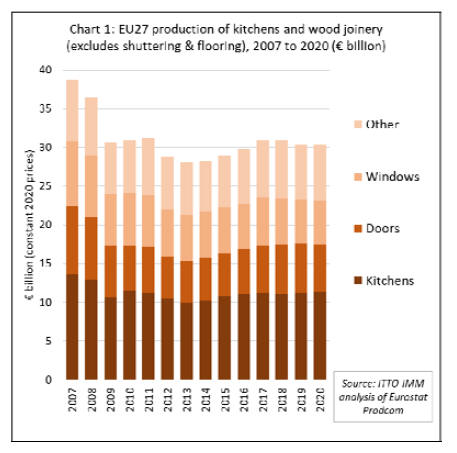
However, the overall figure hides significant variations
between EU27 countries (Chart 2). The most obvious
trend in recent years ¨C which accelerated in 2020 ¨C is the
persistent growth of joinery activity in Germany offset by
a large decline in activity in Italy. Although Italy was still
the second largest joinery manufacturing country in the
EU in 2020, the value of Italian production was less than
half that of Germany last year.
The value of joinery activity in Germany increased 6.0%
to 9.51 billion in 2020, a significant increase in the pace
of growth compared to only 1.6% the year before. In
contrast, production activity in Italy fell 7.8% to 4.41
billion in 2020 following a decline of nearly 15% in 2019.
Italy was more severely affected by COVID-19 than
Germany in 2020, but the contrast in performance with
Germany is also a reflection of a longer-term decline in
Italy's relative competitiveness in wood product
manufacturing.
Trends in wood joinery production in other EU27
countries have been much less dramatic. Joinery
production in France fell 4.9% in 2020, to 3.22 billion,
after rising 2.6% the previous year. Production in Austria
increased 3.6% to 2.09 billion in 2020, continuing a
gradual but consistent and long-term rise.
Joinery production in Poland has slipped a little after
rising strongly between 2013 and 2018, falling 1% to
1.73 billion in 2020. This followed a 2% decline the
previous year.
Joinery production in Denmark (+0.8%), Sweden (+4.7%),
and the Netherlands (+1.9%) was resilient in 2020 in line
with less stringent lockdowns and good activity in the
wider construction sector in those countries.
Joinery production in Spain fell 6.4% to 1.21 billion in
2020 after making a large 9% gain the previous year. In
2018 and 2019, Spain's construction sector was at last
recovering after a very long period of stagnation since the
2008-2009 financial crises.
But in 2020 Spain was hit heavily by the pandemic,
experiencing large numbers of COVID cases, lengthy
lockdowns and massive losses in the tourist trade.
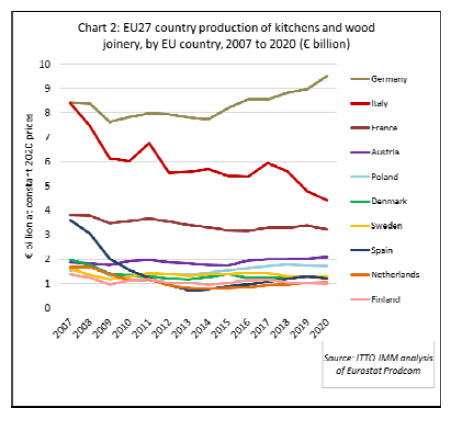
Part of the explanation for slow growth in wood joinery
activity in the EU27 in recent years is increased
substitution by alternative materials.
Eurostat PRODCOM data provides comparable data on
the total value of doors and windows manufactured in the
EU27 in wood, plastic, steel and aluminium respectively.
It shows that while manufacturing of wooden doors and
windows declined in 2019 and 2020, the value of plastic
door and window production has been increasing.
The value of manufacturing of steel doors and windows
declined sharply in 2019 but rebounded in 2020. The
manufacturing of aluminium doors and windows followed
the opposite trend, rising in 2019 but falling in 2020
(Chart 3).
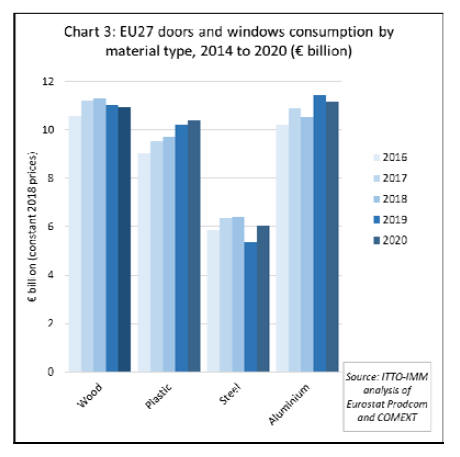
Overall the share of wood in the total value of EU27 door
and window production fell from 30% in 2018 to 28% in
2020. Over the same period, the share of plastic increased
from 26% to 27%, aluminium increased from 28% to 29%,
while steel decreased from 17% to 16%.
There are a wide range of factors behind these shifts in
materials usage in the windows and doors sector, but
material supply and pricing have probably become more
prominent during the pandemic.
There have been widespread reports of extreme shortages
in the supply of timber, steel and aluminium, all of which
have experienced sharp price increases in the EU27 since
the start of the pandemic.
While plastic products were already taking market share ¨C
benefiting from their relatively lower cost ¨C manufacturers
of plastic products less affected by these shortages have
been well placed to take advantage of a surge in demand
for home improvement during the pandemic.
Longer-term, the growth in aluminium consumption in the
EU27 windows and doors sector has been significant.
Aluminium has always remained the default windows
product in the commercial market but has enjoyed
considerable resurgence within the residential window and
door market.
An important driver behind this has been aluminium bifold
and sliding doors as consumers demand greater space
and light within living areas. Another factor is the demand
for lower maintenance and greater strength in light weight
frames for high energy efficiency double and triple glazed
units.
A limitation of the PRODCOM data is that it does not
distinguish products made wholly in wood or metals from
those that are composites of both materials. The
development of wood-aluminium composite window
frames has been a key growth area in the EU27 in recent
years. These products combine the strength and efficiency
of aluminium with the thermal insulation and aesthetic
properties of wood.
Germany, the largest wooden door manufacturer
Eurostat PRODCOM data shows that the total value of
wooden doors supplied to the EU27 decreased 2% to
6.31 billion in 2020 following a 1% decline the previous
year. Most new wooden door installations in the EU27
comprise domestically manufactured products.
The EU27‘―s domestic production also declined by 2% in
2020, to 6.13 billion (Chart 4).
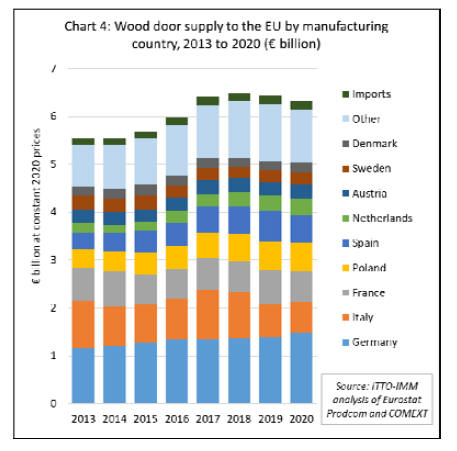
There was significant variation in the performance of the
wooden door sector in EU27 countries in 2020. Production
in Germany, now by far the largest wooden door
manufacturing country, increased 5% to 1.47 billion
during the year, continuing an uninterrupted rise since
2009.
Wooden door production in Italy fell 4% to 660 million
in 2020, a relatively minor decline compared to the 27%
decrease the previous year. Production in France fell 8%
to 650 million in 2020 after a 9% rise in 2019.
Production in Spain was down 10% to 580 million in
2020 after a 9% gain in 2019.
Elsewhere there was robust wooden door production
during 2020, with a rise of 5% to 330 million in the
Netherlands, 4% to 250 million in Sweden, and 9% to
200 million in Denmark. Production was stable in Poland
and Austria during 2020, at 590 million and 300 million
respectively (Chart 5).
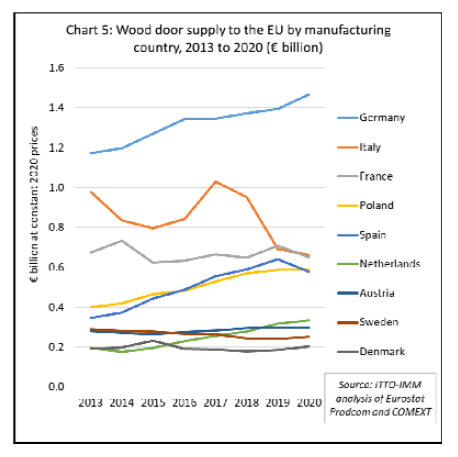
Wooden door imports into the EU27 decreased by 4% to
184 million in 2020 (Chart 6). Imports accounted for
2.9% of the total euro value of wooden door supply to the
EU27 in 2020, slightly less than 3.0% the previous year.
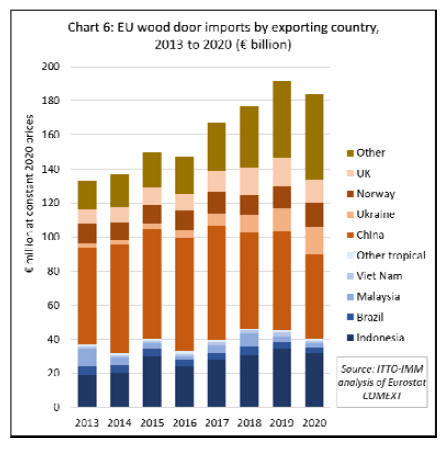
Due to rising freight rates and other supply issues, a
smaller share of EU27 wooden door imports were sourced
from tropical countries during 2020. Total EU27 imports
from the tropics were 40.2 million in 2020, 11% less than
in 2019. This contrasts with a decline of only 2% from
temperate countries to 143.8 million in 2020.
In 2020, wooden door imports were down 8% to 31.6
million from Indonesia, down 8% to 3.5 million from
Brazil, down 31% to 2.5 million from Malaysia, and
down 31% to 1.6 million from Vietnam. EU27 imports of
wooden doors from China, still the largest single external
supplier, fell 14% to 49.9 million in 2020. In contrast,
imports from Ukraine increased 22% to 16 million in
2020 building on a 23% increase the previous year.
Wooden door imports from the UK, now an external
supplier to the EU27, fell 16% to 13.8 million in 2020,
partly owing to pandemic related supply problems and
partly to changing distribution networks after the UK's
departure from the EU at the start of 2020.
An even more pronounced decrease in EU27 door imports
from the UK is expected in 2021 as the UK only left the
EU single market on 1st January this year following a 12
month transition period.
The European wooden door industry is now dominated by
products manufactured using engineered timber driven by
requirements to comply with higher energy efficiency
standards and efforts to provide customers with more
stable products and long-life time guarantees.
Another key trend is towards composite doors with a steelreinforced
uPVC outer frame with an inner frame
combining hardwood and other insulation material. These
products are designed to combine strength, security,
durability, high energy efficiency, with a strong aesthetic.
There may be a place for tropical hardwoods in the design
of these products with manufacturers looking to combine
high quality, consistent performance, regular availability,
and good environmental credentials with a competitive
price.
EU market for wooden windows
The total value of wooden windows supplied to the EU27
fell 1% to 5.76 billion in 2020 following a 4% decline the
previous year (Chart 7).
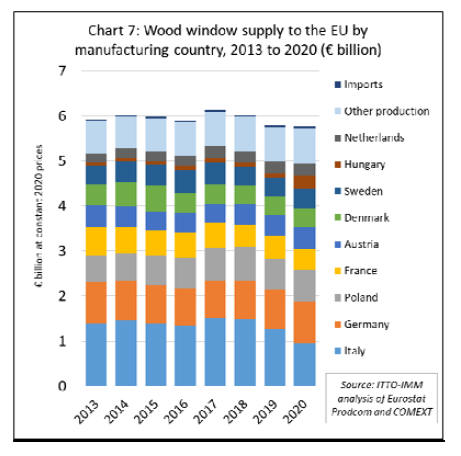
The supply of wooden windows to the EU27 is
overwhelmingly dominated (over 99%) by domestic
production which fell 0.6% to 5.72 billion in 2020. Italy
just maintained by the slimmest of margins its position as
the largest wooden window manufacturer in the EU in
2020, despite production slumping 25% to 950 million.
Wooden window production also declined in Poland (-2%
to 680 million) and France (-4% to 480 million) during
the year.
Production in Germany increased 8% to 940 billion in
2020 after a 0.5% rise the previous year. In 2020
production also increased in Austria (+2% to 470
million), Denmark (+5% to 430 million), Sweden (+2%
to 420 million), and the Netherlands (+1% to 270
million) (Chart 8).
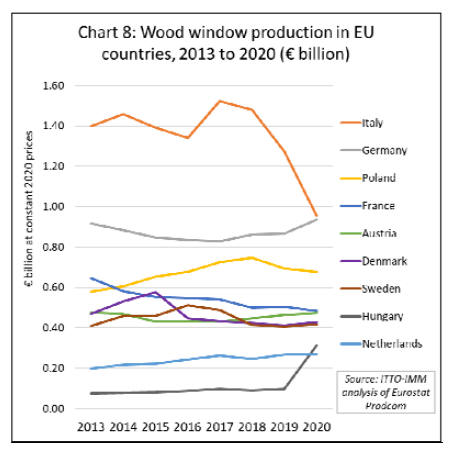
EU imports of wooden windows from outside the EU
decreased by 13% in 2020 to 36.7 million (Chart 9).
Imports from Belarus, now the largest external supplier,
increased 61% to 7.5 million in 2020, continuing a rising
trend that started in 2017. However imports fell from
Norway (-10% to 7.1 million), the UK (-71% to 4
million) and Bosnia (-24% to 3.3 million).
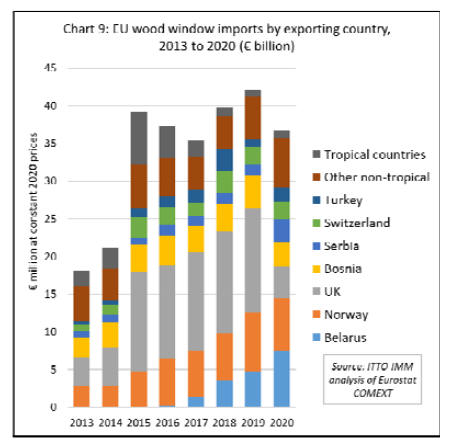
Only a tiny quantity of wooden windows is imported into
the EU from tropical countries. After a spike in imports of
7 million in 2015, mainly from the Philippines, imports
from tropical countries fell to less than 1 million in 2019
and were still around that level in 2020.
While tropical countries are not significantly engaged in
the EU market for finished windows, this sector is of
interest as a source of demand for tropical wood material.
From this perspective, a notable trend in the EU window
sector ¨C as in the door sector - is towards use of
engineered wood in place of solid timber. This is
particularly true of larger manufacturers producing fullyfactory
finished units that buy engineered timber by the
container load.
Increased use of engineered wood is closely associated
with efforts by window manufacturers to meet rising
technical and environmental standards, provide customers
with long lifetime performance guarantees and recover
market share from other materials.
Increased focus on energy efficiency means that tripleglazed
insulating window units with very low U-factors
are now more common than double-glazed units in
Europe. These units demand thicker, more stable and
durable profiles that in practice can only be delivered at
scale using engineered wood products or by combining
wood with aluminium and steel in composite products.
The quality and engineering of wooden windows has
undergone a revolution in the EU in recent years so that
manufacturers are now able to deliver products with many
of the benefits previously reserved only for the best quality
tropical hardwood frames using softwoods and temperate
hardwoods.
Factory-finished timber windows are given a specialist
spray-coated paint finish for even and durable coverage
which might only need redoing once a decade. The
lifespan of factory-finished engineered softwood frames is
now claimed to be about 60 years, while thermally or
chemically modified temperate woods can achieve around
80 years.
Nevertheless, smaller independent joiners producing
bespoke products in low volumes still tend to rely on solid
timber purchased from importers and merchants to
manufacture window frames. Tropical woods such as
meranti, sapele and iroko continue to supply a high-end
niche in this market sector.
The opportunities for wood suppliers in the EU27
windows sector are significant ¨C the total value of wooden
windows sold in the EU27 in 2020 was 5.24 billion, a 1%
gain compared to 5.19 billion the previous year.
The downside is that this is a highly competitive market
that has yet to achieve any significant growth despite all
the promise offered by wood's excellent thermal insulation
and other environmental credentials compared to other
materials and the recent strong emphasis on improved
product performance and efficiency.
When adjusted for inflation, the value of EU27 wooden
window consumption in 2019 was at the lowest level
recorded for at least the last twenty years ¨C and the
increase in consumption in 2020 was only marginal.
Perhaps more than ever before, there is now an
opportunity to turn the tide. There is a very strong focus
in the COVID-19 recovery plans on long-term economic
and social ‘°resilience‘±. NextGenerationEU, the 750
billion ($888 billion) economic recovery instrument now
being rolled out across the EU in response to the
pandemic, is explicitly linked to the EU Green Deal, a
radical project to cut EU emissions by 55% compared to
1990 levels by 2030 on the way to making the EU climate
neutral by 2050.
37% of NextGenerationEU finance is earmarked for
achievement of European Green Deal objectives with
activities to include a large program of building renovation
and support for the ‘°circular economy‘± and sustainable
investment. There is a rising expectation that demands for
formal Environmental Product Declarations (EPDs) and
so-called Product Environmental Footprints (PEFs), will
become much more widespread, particularly in the
construction sector as more building projects are subject to
mandatory environmental assessment.
The projected costs of these Green Deal measures are
enormous, requiring an additional 82 billion to 147
billion in spending every year until 2030, about half a
percentage point of the EU‘―s GDP. Beyond 2030, the
additional investments are 1% to 2% of GDP, about 4.6
trillion between 2031 and 2050.
If wooden products, with all their carbon benefits and
natural and sustainability credentials cannot thrive in this
market environment and begin to retake share from fossil
fuel intensive materials like plastics, aluminium and steel,
then they never will.
|